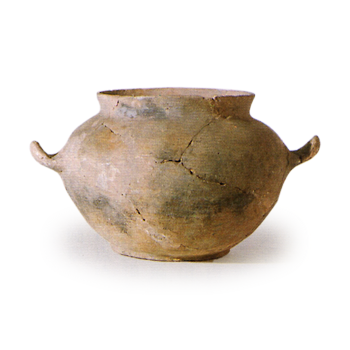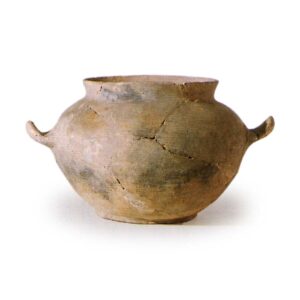
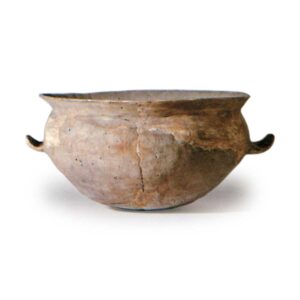
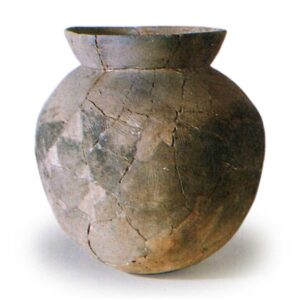
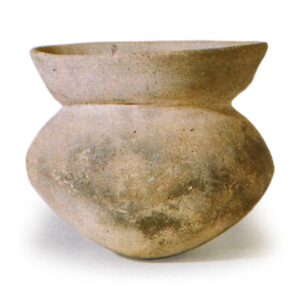
Hajiki is the successor to Yayoi earthenware, a type of unglazed earthenware with a brownish color produced after the Kofun period, which later became Kawarake and has continued to the present day in terms of its phylogeny. In general, while Sue ware: which was used almost in parallel, has many angular forms, Doji ware is characterized by its roundness. The name “doji” originally meant “earthenware made by doji,” or earthenware makers, according to the Engishiki (Engi Shiki). According to the Engishiki, the two countries that paid tribute to earthenware were Yamato (Nara Prefecture) and Kawachi (Osaka Prefecture), and in Yamato there were two types: those that paid tribute to nabe, tamate-doshi and doji, and in Kawachi there were two types: doji and 坏作土師. The “Nihon-shoki” (Chronicles of Japan), however, mentions that there were two types of doji. However, in the 17th year of Emperor Yusei’s reign, the Nihon-shoki (Chronicles of Japan), it is written that when Doji-ren and others were ordered to serve “purification vessels for serving meals,” they served my people from the six provinces and called them “Doji-bu” (Doji-bu at his estate). Although we do not know whether this is true or not, there is no doubt that the Dojishibu were involved in the production of red ware earthenware during the Kofun period.
However, it is assumed that the earthenware produced by the Dojishibu artisans was only a small portion of the total, so the term “Dojishi-ware” generally refers to the same type of earthenware, including that which is assumed to have been produced by Dojishibu artisans and the periods before and after that time period. It is still largely unknown at what point the change from earthenware to kawarake can be traced. Since earthenware is the successor to Yayoi earthenware, its production techniques were also inherited from those of Yayoi earthenware. Compared to Yayoi earthenware, which may have been refined a little, the clay used for Doji ware has fewer large grains of sand. Some of the clay is relatively dense clay with fine sand mixed in. Clay strings are made and formed by the winding technique, and according to Taku Tanaka, three types of forming techniques have been identified. The first is to wind the clay string from the center to the left over the large leaves of the plant, which is used for large, flat-bottomed objects. The third method is to form the bottom in a mold with a spherical concave top and roll it up around to the left, which is mainly used to make deep round-bottomed vessels such as jars and pots. In the second step of the molding process, the clay is scraped with a spatula to make the vessel walls thinner, and the excess clay is removed. The brush marks left by this process are evident. The surface of the vessel was then polished with a spatula to make the surface denser, or perhaps by brushing it with a damp linen cloth. Some shallow vessels have so-called “dark patterns,” which are continuous arc, radial, or spiral patterns drawn in the manner of polishing. Although no kiln sites have yet been found for earthenware, it is thought that it was fired by oxidation at a temperature of around 800°C (800°F), as estimated from the product. Although there are many points where it is still unclear whether earthenware was established in the Kinai or Setouchi region, the stratigraphy of the Uetamachi site in Matsubara City, Osaka Prefecture, excavated by Shozo Haraguchi, is important. The lowest layer is Yayoi style earthenware of the fifth Kinai style, and the second layer consists of jars and pots with rounded bottoms, with the inner surfaces scraped and the outer surfaces brushed to make the walls thinner. This is a molding method characteristic of earthenware. Nunodome-style earthenware dating to the latter half of the 4th century was excavated from the third layer. Based on the changes in the earthenware found at this site, Shozo Haraguchi believes that the Kinai region was one step earlier than the Setouchi region in the appearance of the round bottom, which is characteristic of earthenware. The basic components of Doji ware are jars and high cups, inherited from the Yayoi earthenware set, and small round-bottomed jars, which are characteristic of Doji ware. When the production of Sue ware began, the small round-bottomed jars disappeared, and the influence of Sue ware on the production of vessels such as grudges and various other vessels imitating the shapes of Sue ware was generally significant. In contrast to Sue ware: which was suitable for storage, earthenware pots and steamer vessels were developed for boiling. However, earthenware remained the main vessel in daily life. The ratio of earthenware to Sue ware is overwhelmingly Earthenware, at 83%, and Sue ware: at only 17%, among the 401 pieces of earthenware discovered in a pit at the Heijo Palace site, which is estimated to date back to 763. Jars, pots, and kamado used for boiling and cooking accounted for 11.4% of the earthenware, and bowls, plates, cups, vessels, and high cups used for eating accounted for the majority at 873%, with a few storage jars in addition. At ordinary dwelling sites, more cooking vessels were found than tableware, indicating the unique dietary habits of the Heijo Palace, but even at ordinary dwelling sites, more earthenware was found than Sue ware.
From the late 19th to the 9th century, there was a tendency to simplify the production techniques of earthenware as much as possible, and at the same time, there was a decrease in the variety of vessel forms and the size of vessels. This is thought to be the result of an attempt to mass produce without introducing new techniques, and black earthenware and tile ware were established in an attempt to break away from this conservative approach. In addition, salt makers’ pottery, which belongs to the earthenware lineage, was separated early on for special purposes and developed in its own way. Rubbed earthenware was produced in Hokkaido around the Nara period (710-794), and is characterized by a distinctive brush pattern on the interior and exterior surfaces. The term “rubbed pattern” refers to the brushwork pattern, and was strongly influenced by earthenware. Although unrelated to earthenware, there is a unique type of earthenware produced from the northeastern part of Hokkaido to the Kuril Islands and Sakhalin Island, or the region facing the Sea of Okhotsk, during the Heian period, which is called Okhotsk-style earthenware. The earthenware is often reddish brown or dark brown in color, deep bowl or jar shaped, and decorated with various patterns. The distinctive design technique is a thin floating pattern made by pasting liquid clay through a tube.

